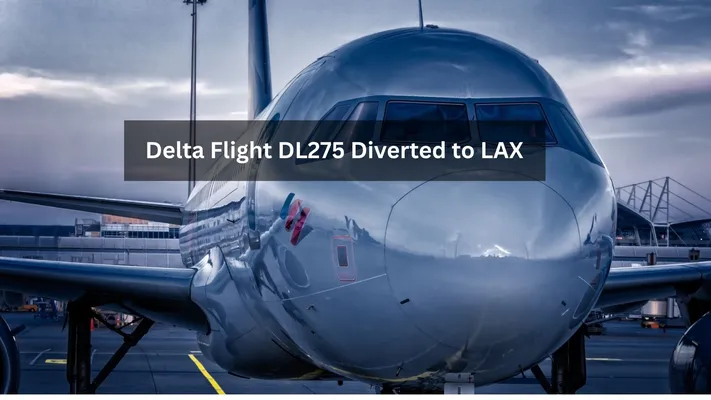Introduction
Delta Air Lines Flight DL275 departed Detroit Metropolitan Wayne County Airport DTW on May 28, 202,5, for Tokyo Haneda. Airbus A350-900 powered by Rolls-Royce Trent XWB engine cruised across the Pacific without incident untithe l crew noticed a malfunction with one engine’s anti-ice systems. The pilots decided to divert from the transpacific route and instead fly to Los Angeles International Airport.
The plane landed safely, but this event shows how airlines handle technical emergencies, and future technology could help to prevent them.
The Incident: A Step-by-Step Account
Flight DL275: Route and Aircraft Information
Route: Detroit Haneda Airport (HND) – Tokyo Haneda Airport (DTW).
Aircraft: Airbus A350-900
Engines: Rolls-Royce Trent XWB
Occupants: More than 300 passengers and crew
Initial Flight Path and Systems Alert
The crew was alerted by the anti-ice system after several hours of normal flying. This system is crucial to performance and safety at high altitudes, as it prevents ice from accumulating on the engine sensors and inlets.
Los Angeles: The Decision to Redirect the Flight is Critical
If the anti-ice system had failed, flying on to Tokyo would have required hours of flight over remote and icy areas with limited options for diversion. Los Angeles was chosen because of its maintenance capabilities, long runways, and strong passenger support.
Air traffic control and ground teams: What are their roles?
The air traffic controllers gave priority to DL275. Delta prepared its maintenance crews as well as passenger support teams on the ground for their arrival.
The Safe Landing under Pressure
The aircraft safely landed at LAX. There were no injuries reported. The aircraft was out of service for around 18 hours as maintenance teams checked the engine.
The Cause and Its Financial Impact
Understanding the Engine Anti-Ice System Problem
Anti-ice systems direct heated air to vulnerable areas of the engine to prevent ice from forming. A malfunction could cause an airflow disruption, sensor error, or engine damage. The crew treated the DL275 system as a possible failure because it showed abnormal readings.
Delta Air Lines: The financial toll
According to industry estimates, the cost of diversion is estimated at US$2.3 million.
Cost Breakdown
Direct Costs: Fuel, Diversion Handling, Inspections, and Repairs
Passenger Costs: Hotels, Meals, and Rebooking
Loss of revenue: The canceled Tokyo segment and its ripple effects on scheduling
Technology and the Future of Aviation
Could AI have predicted and prevented this?
AI-powered predictive maintenance can detect anomalies and prevent them from becoming failures. Advanced data analysis could have detected wear or stress in the anti-ice systems earlier, potentially preventing an in-flight warning.
Predictive Maintenance: The Power of Predictive Maintenance
Airlines can detect trends in component condition using real-time monitoring models and machine learning. A wider adoption of the technology could reduce expensive diversions.
What Airlines are doing to Adopt New Technology
Carriers are increasing sensor use, sharing engine data with manufacturers, and investing more in analytics platforms to predict failures better.
Challenges of Regulatory Frameworks and Certification
To gain regulatory approval, new predictive tools need to prove their reliability. To balance safety and innovation, certification is a carefully considered process.
Cybersecurity Considerations
Protecting aircraft systems from cyber threats is as important as mechanical security, as aircraft systems become increasingly interconnected. Cybersecurity is now a part of aviation safety planning.
The Crew and Passenger Experience
Professionalism at the Cockpit and Cabin
Pilots declared an emergency and took decisive action to divert. Cabin crew reassured passengers and prepared cabins for landing.
Inside the Cabin – Communication and Calm
The crew communicated clearly with passengers, who reported that they were able to reduce their anxiety. After landing, hospitality measures like rebookings or hotel arrangements helped reduce frustration.
After-Landing Operation
Delta rebooked passengers on later flights, provided accommodations for those who were delayed, and sent out maintenance teams to repair the aircraft.
What to Know as a Traveler: Lessons Learned
Diversions, however, are not failures. They are preventative measures.
Clear communication helps passengers stay calm.
Keep essentials (medications, chargers, and travel documents) in your carry-on bag to make unexpected diversions easier.
Travel insurance and flexible tickets reduce stress in the event of disruptions.
Broader Industry and Public Context
Media coverage and social media reactions
While news outlets focused on technical issues, social media highlighted stories of passengers and disruptions to travel. Aviation analysts described the diversion in terms of safety protocols being implemented as intended.
Aviation Industry Lessons
Even on the most advanced aircraft, supporting systems such as anti-ice are still essential.
Predictive maintenance is both safe and cost-effective.
Crew training continues to be vital, as does rapid decision-making.
Frequently Asked Questions (FAQs)
Q. Why was Delta Flight DL275 diverted to LAX from Tokyo?
A: Due to a malfunction of the anti-ice system in one engine, it is unsafe to continue to Tokyo.
Q: What caused the engine issue?
A: The anti-ice system failed or showed abnormal readings, likely involving valves or sensors.
Q: How much did the diversion cost Delta?
A: Around US$2.3 million, including fuel, repairs, hotels, and lost revenue.
Q. How can I remain calm during a flight diversion?
A: Trust the crew and follow their instructions. Also, remember that safety is always put first. Use relaxation techniques and carry essentials with you.
Q. How frequent are these types of diversions?
A: They’re not uncommon, but they are rare. Aviation’s safety system includes diversion for medical or technical reasons.
Conclusion: A Testament to Modern Aviation Safety
The diversion of Delta Flight DL275 shows the importance of aviation safety. Technical alerts prompted swift decisions, coordinated assistance, and a successful landing. The event was costly but reinforced the importance of safety, training, and technology.
In the future, AI, predictive analytics, and improved monitoring could reduce similar diverts. This incident is proof that professionalism and preparation are key to keeping passengers safe when systems fail.
